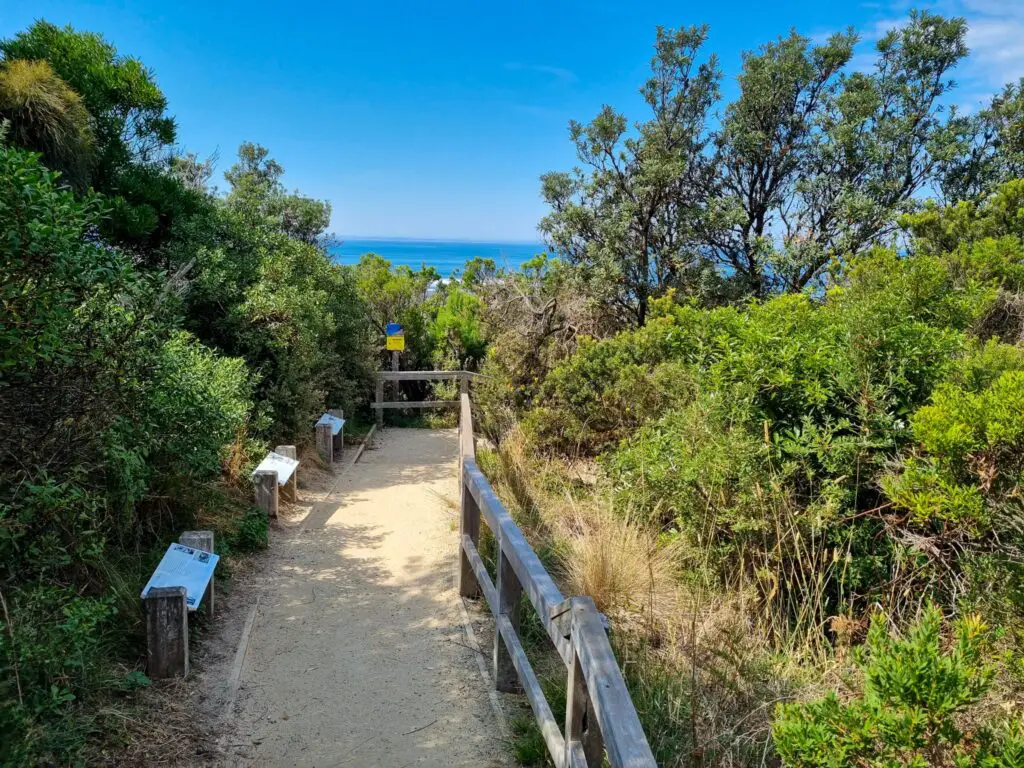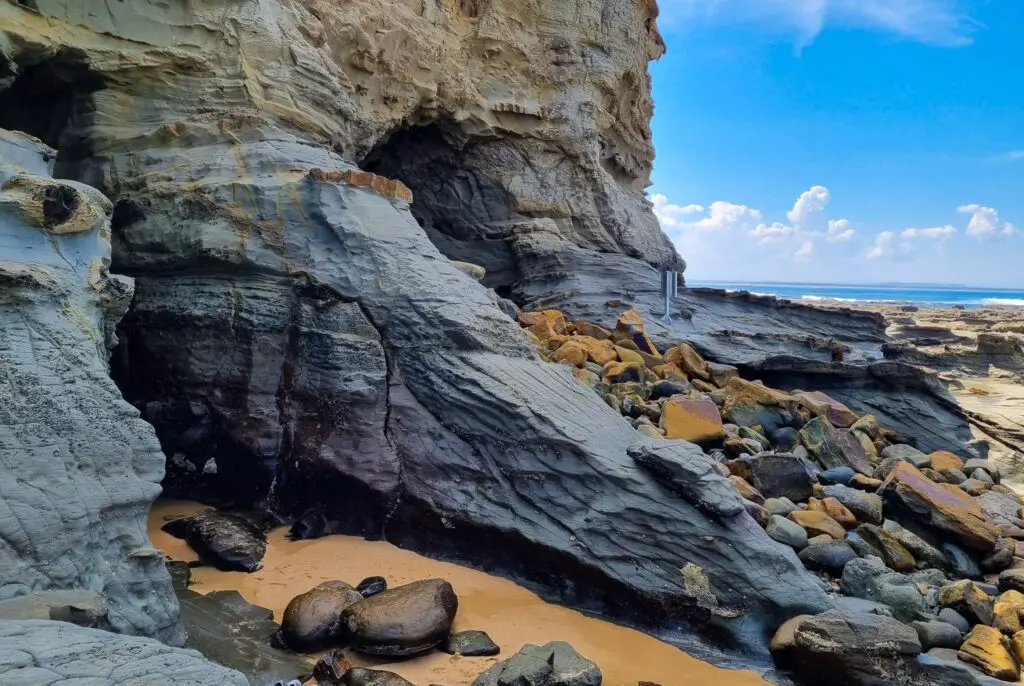Between Cape Patterson and the popular seaside town of Inverloch in Gippsland, Victoria, is a strip of coastline renowned not only for its natural beauty, but its spectacular and significant geology. In fact, this coastline, otherwise known as the Bass Coast, is one of the best areas for fossils in Victoria. And not any old fossils either – dinosaurs!
Bones and teeth of Carnosaurs, Theropods, Ankylosaurs, Ornithomimosaurs and many other dinosaurs and primitive species have been found along the Bass Coast. They’re said to be an incredible 115 – 126 million years old.
Dinosaur Dreaming, 6kms from Inverloch, is one of the most famous dig sites. Over 1,000 items are excavated each annual field session here and preserved by researchers from Monash University and museum Victoria.
Although it’s sadly illegal to do your own fossil hunting, it’s still fantastic fun to visit the Dinosaur Dreaming beach site and visit the caves at Inverloch, carved into the cliffs.
The Caves and Dinosaur Dreaming dig site are one of the highlights of a trip to Inverloch, especially for kids whose imaginations will be sparked by the geological wonders before them.
So if you have a half day, or want to enjoy a rather unusual day at the beach, here’s how to visit The Caves and Dinosaur Dreaming dig site in Inverloch!
How to get to The Caves and Dinosaur Dreaming
Both The Caves and Dinosaur Dreaming are accessed from the same location, 400/600 Cape Paterson-Inverloch Rd, Inverloch. Inverloch is about 150km southwest of Melbourne, Australia.
There is a small Parks Victoria car park (called “The Caves”) which can only accommodate about 15 cars so it gets really busy during peak times and good weather.
From the carpark, a 1 minute walk down a gravel path and wooden steps leads out onto the beach. The Dinosaur Dreaming platform is on the shore, 100m north of the stairs. The Caves are around the headland to the right (west), a few more metres away.

Both Dinosaur Dreaming and The Caves can only be accessed at low tide. It is important that you check tide times before you plan your visit to ensure you don’t miss out!
Why are there dinosaur fossils in Inverloch anyway?

Step back 115 million years and the landscape of the Bass Coast isn’t a coastline at all. In fact, instead of cliffs and sea, it’s the bottom of a flat riverbed in a valley.
All those millions of years ago, South-eastern Australia was located much further south than it is today. Incredibly, it was once joined with Antarctica! According to the information board near the car park, you could have walked to Antarctica without getting your feet wet!
Winter in the Arctic Circle meant that the sun would set and would not rise for two – three months, so it was much darker and colder. Despite this, the great variety of animals and plants fossilised here suggested that they thrived in the harsh conditions.
River beds provide ideal conditions for creating fossils. Mud, sand and gravel settle in the bottom of the river bed and bury living and dead animals and plants. Over time, and with the accumulations of more particles or ‘layers’ (and often chemical changes) the sediment at the bottom converts to rock.
Now exposed, the sedimentary rock provides some of the best fossil-spotting opportunities in Victoria.
Cape Patterson, just 8 minutes west of the Dinosaur Dreaming site, was actually where the first dinosaur fossil (a theropod claw) was found in Australia, back in 1903.
What is Dinosaur Dreaming like?

The dinosaur fossil site in Inverloch is essentially a rocky shore platform called Flat Rocks, with a sprinkling of rock pools throughout it. During low tide, you can get up close and, with your best investigative head on, find some ancient fossils. But just don’t take anything – it’s illegal!
The most exciting thing of all at the dig site has to be the footprints imprinted on the top of rock, 100m north/north-east from the bottom of the stairs.
During the summer (January/February) field researchers take to the site which makes it a fantastic time to visit Dinosaur Dreaming to watch the professional and volunteer excavations in action.
If you want to learn more, or to kick-start your own search when you visit, guided tours to the dig site run during the holidays, or private group tours can be arranged through the Bunurong Environment Centre.
What are The Caves at Inverloch like?

The Caves at Inverloch can be accessed either from The Caves Beach, or Eagles Nest Beach during low tide. There are three very different caves to visit which I have very creatively names cave 1, 2 and 3, which is almost as creative as their official name!
The first cave (approached from The Caves Beach side) had a wide opening with a short-medium tunnel into the rock which narrows. There has recently been some cliff fall and so there are quite a few rocks to walk over to get to the entrance.

Cave one is dry to access (unlike cave two where I had to wade through a small pool of water to access) as it is a little higher up.
This cave has the most impressive layering visible in the sedimentary rock. Due to the nice, wide opening, it also makes a lovely scenic photograph from inside, using the cave entrance to frame the sea and sky. I just wish I brought my SLR instead of only my phone!
The second cave (or middle cave) has a narrower entrance but is longer and I think more interesting to enter. Although you may have to wade through some water to get into it, there is a large sandy ‘bowl’ or cavern inside, which is pretty cool.

From the cavern, the cave narrows back further and if you have a head torch you can walk through the gap. Those who are claustrophobic may not want to adventure beyond the cavern though! The very back of the cave is pretty dark and even with phone torches you may struggle to see properly.
Cave two appears to get more submerged in high tide due to all the barnacles and watermarks along the walls.
The third cave is basically a wide but shallow cavern into the cliff. It’s certainly not as impressive as the other two, but one day it may well go as deep as the other two!
If you miss the low tide, you can often access cave three as it’s higher up and just off Eagles Nest Beach.

Once you’ve thoroughly explored The Caves and Dinosaur Dreaming dig site, there are plenty of lovely rockpools and beds of purple-black mussels growing on the rock.
Kids will love exploring the area or it’ll no doubt bring out your inner child – who doesn’t love spotting sea creatures in rockpools!
Eagles Nest Lookout
Just before you head off home, it’s also worth either walking along Eagles Nest Beach, or driving just a few hundred metres down the road to the Eagles Nest Lookout.
Ok, it may not be the most impressive geological formation you’ve ever seen, but this natural rock attraction, accessed by a short out-and-back track to a viewing platform, is a popular thing to stop and see along the Bunurong Coastal Drive in Inverloch.
Sticking out from a flat platform is a tower of rock that is quite eye-catching. However, I think it looks a little more impressive from down on the beach than from gazing down from the viewing platform.

If you’re there at the right time of year, you may also be lucky enough to spot whales at Eagles Nest Lookout whilst they make their annual migration to Antarctica!
The Caves at Inverloch and the Dinosaur Dreaming fossil site offer a fascinating insight into Australia’s incredible geology. It’s hard to believe that once upon a time there was no sea here at all, and instead just a large river bed abundant with now largely extinct wildlife.
PIN FOR LATER:
Heading to Australia soon? Don’t forget these essentials!
Flights: compare and search using Skyscanner
Accommodation: hotels to hostels, glamping to apartments I always use Booking.com
Tours: to search and compare the best group tours and activities worldwide (with up to 20% off), use Viator
Visa: don’t forget to check the entry requirements for Australia on the government website for the passport you are travelling with
Inspiration: Lonely Planet’s guide to Australia or for your next trip, how about Lonely Planet’s Guide to the World?









Wow, the caves look absolutely stunning! I particularly loved the first photo of this article 🙂 Oh and a lot of useful information as well, great job!
This is soooooo cool! I always love fossil finding, and the caves look sooooo fun to explore too. This looks like it would be fab to visit with kids (or big kids like me who just love this kind of thing!!) 😉
What an incredible place to visit with such a fascinating geological history! The caves look incredible! I’d love to explore them! Thanks for the great guide!
My kids would LOVE to explore the dinosaurs and caves at Inverloch. Looks like the perfect place to hike and enjoy the day.
Wow! I had no idea this type of geological history existed in the area. Yet another reason to get to Australia to explore this great place!
The cave looks so stunning with all the vibrant colors – otherworldly beautiful! Hope to visit one day and see Dinosaur Footprints in the rock with my own eyes as well!
I really enjoy reading this type of blog. It’s fascinating to learn about Dinosaur Fossils, which I had never heard of before reading your article. Thank you so much for sharing; I will continue to support you; please share more and more blogs like this.